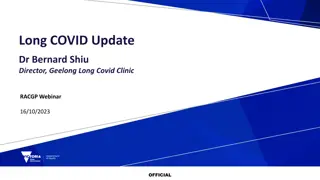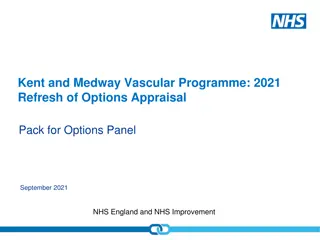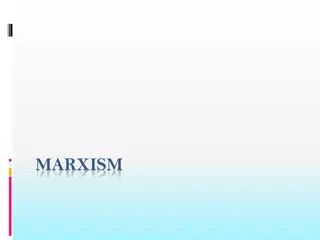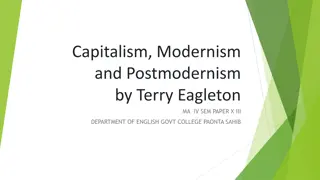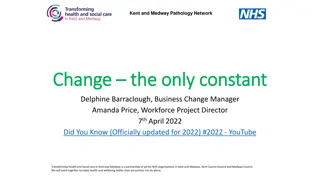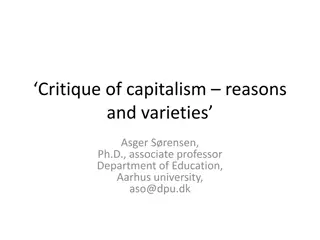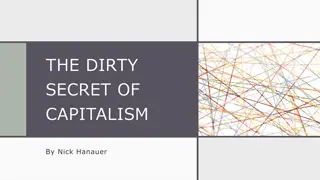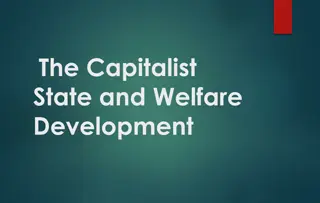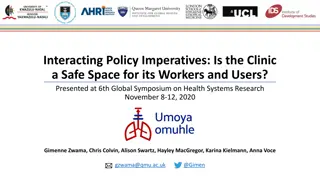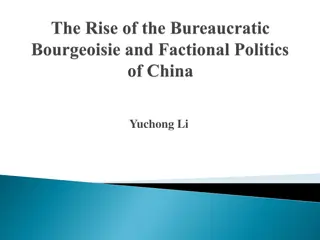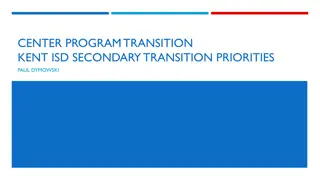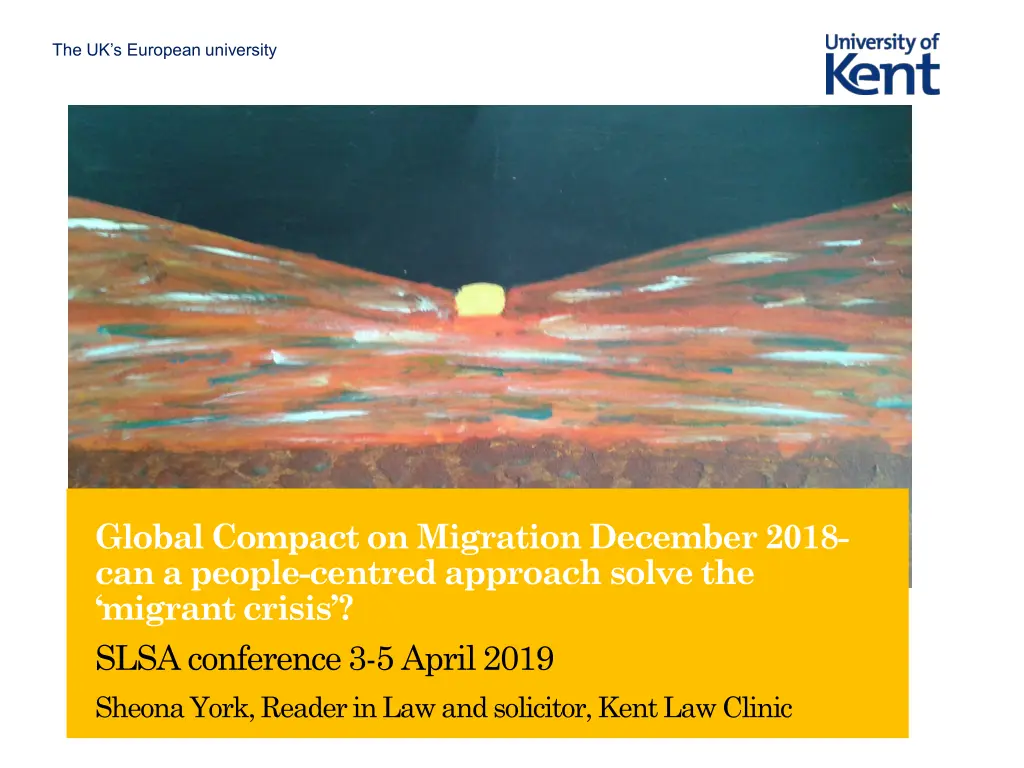
Global Compact on Migration: A People-Centred Solution?
Explore the implications of the Global Compact on Migration, its ambition, and how a people-centred approach could address the migrant crisis. Analyze key points, non-binding nature, and challenges in achieving the set standards globally.
Download Presentation

Please find below an Image/Link to download the presentation.
The content on the website is provided AS IS for your information and personal use only. It may not be sold, licensed, or shared on other websites without obtaining consent from the author. If you encounter any issues during the download, it is possible that the publisher has removed the file from their server.
You are allowed to download the files provided on this website for personal or commercial use, subject to the condition that they are used lawfully. All files are the property of their respective owners.
The content on the website is provided AS IS for your information and personal use only. It may not be sold, licensed, or shared on other websites without obtaining consent from the author.
E N D
Presentation Transcript
The UKs European university Global Compact on Migration December 2018- can a people-centred approach solve the migrant crisis ? SLSA conference 3-5 April 2019 Sheona York, Reader in Law and solicitor, Kent Law Clinic
On 11 December 2018 a UN conference celebrated the adoption of the First-Ever Global Compact for safe, orderly and regular migration . The majority of the world s nation-states have signed up to this. Sending countries should adopt resilience strategies , improve education for women, improve governance etc to reduce the drive to emigrate. Transit and destination countries should provide opportunities for work and study, offer accommodation and health care to migrants Destination countries as well as the above, should reduce precariousness, permit family reunion and encourage integration. Page 2 Footer text
3 important points about this compact: 1.Unlike the UN Refugee Convention, the UN Convention on the Rights of the Child, etc, the Compact is not legally binding. it reaffirms States sovereign rights to determine their national migration policies and to govern migrations within their jurisdictions. 2.The objectives are to be worked on flexibly: As migration experiences and challenges vary across the world, the Global Compact is a flexible instrument that can meet the needs of every country and stimulate joint cooperation at all levels. Page 3 Footer text
3: the most important is the colossal ambition presupposed by the Compact. It must be the first time in which the majority if not all the world s nation states have put their names to what amounts to a detailed description of what social, political, cultural and legal life should be like, in every part of the world, albeit seen through the prism of migration as a global problem . In relation to almost all the specific aims set out in each aspect of the compact, few even first-world countries aspire to, never mind succeed in, providing such high standards, whether of accommodation, subsistence, health care and education or legal rights, even to all of their existing populations. Page 4 Footer text
- The highest aspirations for everyone, all over the world but What is being proposed here is effectively the most highly-regulated and public-spirited management of the global capitalist system to provide a healthy, safe and fulfilling life for everyone, though here with the spotlight on migrants. Yet there is no mention at all of politics, economics, religion, or culture, (and only a bare whisper of a reference to climate change) and therefore no recognition or assessment of the different forces and processes at work in the world which drive migration. Whereas in reality migration, viewed globally, is an outcome of the effects of capitalist forces seeking to overcome barriers to profitable activity. Page 5 Footer text
What drives migration? For individuals, families, communities who move, migration is a responseto the impact of the effects of capitalist forces, whether directly economic (as in loss of jobs or land, degradation of the environment, lack of debt financing, changes in tariff barriers etc) or indirectly as a result of national or international political conflicts (themselves related to those economic changes). For States, policies about migrants, whether leaving or entering, are driven by a mixture of economic and political imperatives, themselves influenced by longer-term cultural, national, religious identification. States can tip suddenly into sending migrants (Syria, Myanmar, Venezuela), or into becoming transit or receiving countries (Italy, Greece, Turkey), and policy-making is almost always reactive. Page 6 Footer text
By examining the recent histories and politics of a sending country, a transit country and a receiving country, I offer a critique of the people-centred approach, and conclude: Such an approach both obscures the true reasons for the ills suffered by migrants,and, by singling out people qua migrants, gets in the way of building solidarity in transit and receiving countries between citizens and those more recent arrivals, arriving at a less legalistic and more humane view of belonging Such proposals fuel populist anti-migrant feeling, itself stigmatised by elites as racist, xenophobic etc while its causes remain unexamined. We are left blaming the wrong people (repressive regimes in Africa, xenophobes in Europe) rather than tackling what is underlying and driving global migration trends. Page 7 Footer text
A sending country Eritrea the North Korea of Africa (The Economist 14/8/2018) Controlled by Italy since around 1870, its people enjoyed some education and access to modern industrial and technical employment. It was run by the UK from 1941, denuded of its modern infrastructure and handed to Ethiopia by the UN in 1952. Its war of liberation from neighbouring Ethiopia, which began in the 1960s and only ended in 1991, was one of Africa s longest-running conflicts. Then, as a newly independent country, it fought a war with Ethiopia between 1998 and 2000, one of the bloodiest in the continent s history, which only formally ended on July 8th of this year [2018]. Eritrea was Africa s largest single source of refugees to Europe from 2014 to 2016. Over the past decade so many people have left that Eritrea has been called the world s fastest-emptying nation . (The Economist 14/8/2018) Page 8 Footer text
one big land prison with religious persecution After its 30-year independence struggle, no constitutional conference was held in 1994 as had been promised, and restrictions on free speech and political activity intensified rather than lessened. Compulsory military and national service, maintained amongst the freedom fighters after independence to aid national reconstruction, and then maintained again after the war with Ethiopia, has been ruthlessly enforced ever since. There has been a shoot to kill policy against people illegally crossing the border, and families of draft evaders have been fined large sums of money and themselves imprisoned and tortured for not effecting the return of their teenage children or disclosing their whereabouts. Pentecostal Christians and Jehovah s Witnesses are persecuted. Page 9 Footer text
Punished for its insistence on independence? Without allies during and since the independence struggle, Eritrea s rulers have both learned and enforced national self-reliance and an intolerance to any kind of opposition. Geopolitical forces since the Second World War (on both sides) argued against political self- determination in post-colonial Africa, and favoured Ethiopia, so Eritrea has had few acceptable allies and little economic support, and is thus one of the poorest countries in the world. Worse than that, the economic support now available to it either sloughs over the complete lack of democratic freedoms in the country (as in a 2018 World Bank report), or ties funds to preventing emigration (as in the EU-based Khartoum project, criticised as concentrating on law enforcement rather than looking at the deep- seated issues of governance and extreme poverty ) Footer text Page 10
A transit country Italy the 8thrichest country in the world, yet vulnerable asylum-seekers are judged to face art 3 harm if returned there under EU Dublin procedures: Italy only united in 1861, is still effectively 2 countries, where the level of capitalist development and economic well-being in the North is far ahead of the rural and still relatively undeveloped South, with wide political differences and even political and social hostility. Italy was until very recently itself a sending country. In the 100 years 1870-1970 some 26 million Italians emigrated, mostly from the North to northern Europe, and from the South to the USA and elsewhere. Then in the recession of the 70 s many of these returned, putting pressure on poor rural areas with no jobs and few public services. Page 11 Footer text
Italian politics and the geopolitical context Maybe influenced by the experiences of Italians working abroad, Italy developed strong Socialist and Communist parties including a major Communist thinker Gramsci. These parties remained well-organised and popular during the Fascist years, played a significant role in the wartime Resistance, and expected to govern postwar. However, following the 1945 US-USSR agreement at Yalta to divide Europe along the Iron Curtain, the US effectively prevented the Communist party from ever entering government, a policy so successful that eventually that party decided never to enter government without the Christian Democrats, and eventually, along with all the other Left groups, disintegrated. Page 12 Footer text
Berlusconi and after Just at the point in 1994 when the remains of the Communist part looked like the only party left standing, Berlusconi, a showman and owner of media companies, struck a deal with the Northern League (under Bossi) and a Southern populist part Alleanza Nazionale (under Fini) and won a series of elections That grouping s rule was interspersed with centre-left governments which presided over the austerity policies needed to achieve convergence and enter the Euro. This led to continuing catastrophic high unemployment especially in the South. Serious problems of organised crime (amounting to 7% of GDP) especially affected the South, preventing development and reform Page 13 Footer text
Italys anti-migrant politics and policies Italy is now governed by the Northern League, now Italy s longest- standing party, the Alleanza Nazionale and a newer grouping, the 5-star movement, each of which presents a different set of national-populist demands, but all agreeing on frank, open hostility not just to migrants, but to all foreigners whether asylum- seekers, economic migrants, poorer EU nationals or marginalised Italian citizens such as Roma. Berlusconi introduced the first restrictions on rescuing migrants from the Mediterranean (and was an early adopter of support for nasty foreign governments in return for their preventing emigration to Europe) These policies have been continued by subsequent governments. Footer text Page 14
must be seen in the context of Italys weak economy, high unemployment and poverty in the South, and the complete collapse of Left politics Italy, next to Greece, is a major target for EU-imposed austerity measures to reduce its enormous public debt. In October 2018 the EU rejected the Italian budget as including too much public spending. Italy, like Greece, is a first safe country under the EU s Dublin Regulation determining where asylum-seekers claims should be processed and so faces accommodating hundreds of thousands of asylum-seekers which the rest of the EU (including the UK) refuse to take Italy s strong traditions of leftwing politics have self- destructed, leaving no social room for any democratic politics of solidarity, or any support for migrants rights. Footer text Page 15
The UK the destination country but until recently, itself a major sending country England, then Britain, then the UK, has seen enormous migration flows both out and in, over centuries. Rulers, military personnel and administrators left to govern and trade in the colonies; desperate migrants fled Ireland from the famine, desperate Scots fled enforced land reform , hundreds of thousands were transported as criminals, and after the war large numbers of families emigrated to Australia and New Zealand seeking a better life. Migrants have entered this island for hundreds of years, but immigration only emerged as a problematised category after the second world war, when citizens of the Empire and Commonwealth began to arrive in numbers. Now, some 14% of the UK population were born abroad, mostly from the EU. Footer text Page 16
The UK (England, Britain) has never truly offered a welcome, or any sustained practical assistance with integration, to any but limited categories of incomers. The State, whether the State of Elizabeth I or subsequently, has always kept a close eye on foreigners and from time to time, depending on England s alliances in foreign wars, has imposed hostile environment-style measures on them. The freedom of movement permitted in the 19th century was based on support for free trade, in a period when large numbers were still leaving Britain from desperation The welcome for refugees has always been heavily qualified and limited, especially against the Jews before the first and second world wars, but also subsequently. Page 17 Footer text
The mainstream political response to immigration has generally been cowardly, discriminatory and hostile: The British Nationality Act 1948 made everyone born in the British Empire and Commonwealth a citizen of the UK and Colonies . It did not occur to those legislators, who prided themselves on not being racist, that the natives or the coloured people would actually travel to the UK to make their home here. During the 1950 s, soon after the Windrush arrivals began,, both Labour and Conservative politicians discussed how these arrivals could be restricted, but were stymied by not wanting to restrict the arrivals of white emigrants from the old Dominions (Canada, Australia, South Africa etc) Those discussions were kept private and not until after the race riots in 1958 did immigration reach the surface Page 18 Footer text
Cowardly . Unlike for the resettlement of displaced Europeans after the war, the Windrush arrivals were offered no help with housing, language or other needs, so where new migrant arrivals were concentrating, there were serious shortages of housing, school places and even health treatment. Some local trade union branches in some workplaces took trouble to recruit newly-arrived black workers, but trade unions nationally did not campaign against race discrimination, or for housing and school places to be provided Labour nationally made statements against race discrimination, but did not argue for increased resources for the areas facing pressure on housing. Their response was to say nothing, but introduce immigration restrictions. Page 19 Footer text
Discriminatory The political agonising over the early restrictive legislation of the 60 s and 70 s was precisely over how to discriminate against non-white entrants, even those who had citizenship of the UK and colonies. This was done by giving preferential treatment to those with a parent or grandparent born in the UK, and, for aliens , permitting visa-free entry to those from certain favoured countries. Even in the realm of asylum (in its modern form a category principally intended to assist individual Cold War defectors), those from certain countries and certain conflicts, or with certain kinds of claims, found it easier to be accepted. Page 20 Footer text
Hostile The 1979-1997 Conservative government very quickly removed migrants rights to social benefits and social housing except in very specific circumstances The 1997-2010 Labour government set up a parallel and lower- standard social housing and subsistence system for asylum- seekers, among other restrictive measures Anti-asylum-seeker and anti-migrant rhetoric used by both parties, while both praising the brightest and best from abroad and welcoming genuine refugees Charging for health treatment, documentary proof of the right to work and other hostile measures brought in by both parties Now all migrants without permanent residence are legally classed as precarious , and family reunion is restricted and expensive. Page 21 Footer text
UN Special Rapporteur on extreme poverty and human rights in the UK: (16 November 2018) the immense growth in foodbanks the people sleeping rough on the streets, the sense of despair And local authorities, which provide vital roles in providing a real social safety net have been gutted by a series of government policies the focus of this report is on the contribution made by social security and related policies. The results? 14 million people, a fifth of the population, lives in poverty. Four million of these are more than 50% below the poverty line, and 1.5 million are destitute, unable to afford basic necessities For almost one in every two children to be poor in twenty-first century Britain is not just a disgrace, but a social calamity and an economic disaster, all rolled into one. poverty is a political choice Page 22 Footer text
Conclusion - Arguably, as with Italy, to advocate pro-migrant policies from above , or from outside , without winning political debate among the national electorate, and achieving democratic support and solidarity for migrants as people who may belong here just as citizens do will create hostility to migrants. This is shown, surely, by the numbers of people in poor and so-called left behind communities in the UK who have voted for parties and policies demanding fewer immigrants, rather than campaigning for solidarity with them and an end to austerity for all. We need a political debate on belonging which challenges this divide which unfortunately cannot come from an aspirational international statement appearing to prioritise rights for migrants . Footer text Page 23
THE UKS EUROPEAN UNIVERSITY www.kent.ac.uk Footer text Page 24

